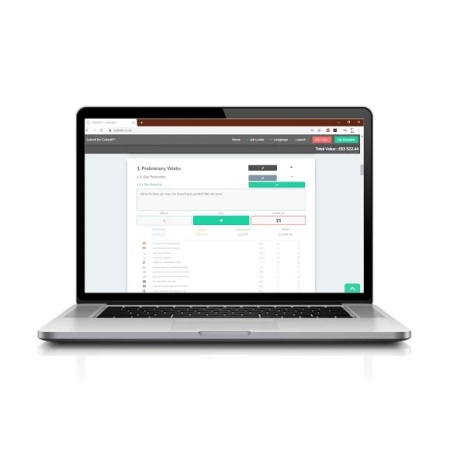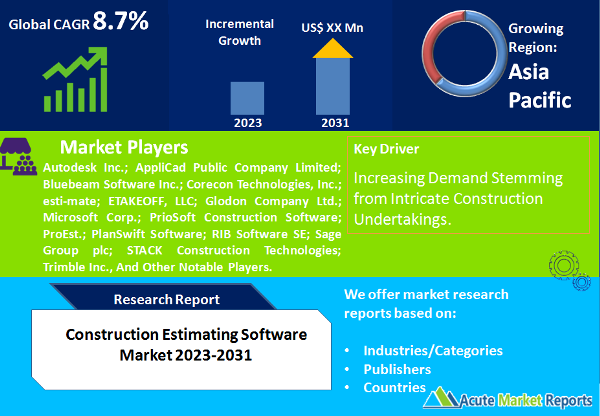
The construction estimating software market acts as the cornerstone of the construction tech segment, offering contractors, developers, and planners a structured approach to anticipate project expenses, from raw materials to human resources. This digital solution not only minimizes the potential for errors but also saves significant time and monetary resources. As the global construction landscape undergoes rapid transformation, the importance of such high-efficiency, dependable tools cannot be understated. However, the decision to adopt this software is influenced by a plethora of catalysts and challenges. Construction estimating software market is estimated to grow at a CAGR of 8.7% from 2025 to 2033, propelled by the global construction industry's evolving needs, the allure of time and cost efficiencies, and the broader digitalization wave.

Increasing Demand Stemming from Intricate Construction Undertakings
Globally, there's a marked trend towards urbanization. This shift necessitates the construction of advanced infrastructural elements. Cities, especially in emerging economies, are rife with projects of profound complexity. For instance, the multilayered transportation hubs being developed in parts of Europe are so intricate that any cost misjudgment could lead to substantial financial setbacks. Green Building Movement: With the environmental crisis at the forefront, there's a global push for sustainable constructions. These buildings, with their specialized materials and innovative techniques, command a unique set of cost determinants. As cities like Toronto push for greener skylines, accurate cost forecasting becomes pivotal.
Essential Time Optimization and Expense Minimization
Eliminating Potential Errors: A single error in manual estimation can cascade into considerable monetary loss, as was evidenced in a residential project in California where a miscalculation led to a budget overrun of 20%. The modern construction landscape is driven by timelines. The quicker a project moves from the drawing board to the ground, the better. Several infrastructure projects in countries like Brazil have showcased how swift project sanctioning post-estimation can significantly reduce costs in the long run.
Digitalization and Seamless Tech Integration within Construction
Compatibility with Varied Software Tools: Current construction estimating tools can effortlessly mesh with other digital management solutions. For instance, the seamless integration of these software tools with project management and procurement systems was underscored during the development of a commercial hub in Berlin. BIM, or Building Information Modeling, offers a detailed digital layout of a building's physical and inherent traits. Integrating construction estimating software with BIM provides holistic insights. Major infrastructural ventures in places like Singapore frequently use this duo for comprehensive project visualization and costing.
Initial Setup Expenses and Need for Skill Enhancement
While top-tier construction entities can readily bear the initial expenses of advanced estimating software, it's a significant burden for smaller firms. Feedback from various small-scale developers in regions such as Latin America revealed their reluctance to transition to digital solutions primarily due to these initial costs. New software adoption invariably requires intensive training. Places that experience a technological skill shortage, like certain African countries, often display a marked hesitation towards these software tools. The apprehension mainly stems from the anticipated prolonged training phase and adaptation curve.
Market Segmentation by Software Licence
In the rapidly evolving construction estimating software market, a more granular analysis reveals intriguing trends within distinct segments. When categorizing by software license type, the market can be divided into Perpetual License, Subscription License, and Others. In 2024, Subscription License models dominated in terms of revenue generation. This trend can be attributed to the flexibility and scalability they offer to users, especially beneficial for medium and small-scale firms that might not have the financial clout to invest in perpetual licenses. It was observed that these subscription models often came with regular software updates, further attracting a larger customer base. However, when it comes to the Compound Annual Growth Rate (CAGR) from 2025 to 2033, the 'Others' category, which comprises newer licensing models such as pay-as-you-go and freemium, is anticipated to experience the steepest growth. As companies continually seek innovative means to penetrate deeper into the market and lure hesitant prospects, these alternative licensing models are expected to flourish.
Market Segmentation by Deployment Model
Diving into deployment models, the market largely revolves around Cloud and On-premise solutions. In 2024, Cloud-based deployment overshadowed its on-premise counterpart in revenue generation. The allure of cloud solutions stems from remote accessibility, scalability, and minimized IT overheads. For instance, companies undertaking multiple projects spread across vast geographies found immense value in cloud solutions, enabling teams, irrespective of location, to collaborate seamlessly. Looking at the period between 2025 to 2033, Cloud deployment is also projected to register the highest CAGR. The world is unmistakably shifting towards cloud-first strategies, and construction estimating software isn't immune to this trend.
Asia Pacific Leads the Market
Region-wise, the Asian market, led by nations such as China and India, boasted the highest revenue percentages in 2024. This can be attributed to the immense infrastructural developments underway in these emerging economies and their gradual but noticeable shift towards tech adoption in construction. As for the expected CAGR from 2025 to 2033, the African continent, though starting from a relatively lower base, is poised to witness an unprecedented surge. Countries like Nigeria and South Africa are on the cusp of a construction boom, with technology playing a pivotal role in shaping their industry's future.
Competitive Landscape
On the competitive front, 2024 saw fierce rivalry among top players, including Autodesk Inc.; AppliCad Public Company Limited; Bluebeam Software Inc.; Corecon Technologies, Inc.; esti-mate; ETAKEOFF, LLC; Glodon Company Ltd.; Microsoft Corp.; PrioSoft Construction Software; ProEst.; PlanSwift Software; RIB Software SE; Sage Group plc; STACK Construction Technologies; Trimble Inc., to name a few. The overarching strategy was an aggressive push towards integrative capabilities, wherein construction estimating software could seamlessly communicate with other essential tools, ensuring a holistic project management experience. Enhanced user interface, augmented reality integrations, and machine learning capabilities were among the key offerings differentiating the market leaders. As we gaze into the horizon, from 2025 to 2033, the competition is expected to intensify. Companies are likely to focus on expanding their global footprint, especially in untapped markets, while continuously innovating to stay ahead of the curve.
Historical & Forecast Period
This study report represents analysis of each segment from 2023 to 2033 considering 2024 as the base year. Compounded Annual Growth Rate (CAGR) for each of the respective segments estimated for the forecast period of 2025 to 2033.
The current report comprises of quantitative market estimations for each micro market for every geographical region and qualitative market analysis such as micro and macro environment analysis, market trends, competitive intelligence, segment analysis, porters five force model, top winning strategies, top investment markets, emerging trends and technological analysis, case studies, strategic conclusions and recommendations and other key market insights.
Research Methodology
The complete research study was conducted in three phases, namely: secondary research, primary research, and expert panel review. key data point that enables the estimation of Construction Estimating Software market are as follows:
Market forecast was performed through proprietary software that analyzes various qualitative and quantitative factors. Growth rate and CAGR were estimated through intensive secondary and primary research. Data triangulation across various data points provides accuracy across various analyzed market segments in the report. Application of both top down and bottom-up approach for validation of market estimation assures logical, methodical and mathematical consistency of the quantitative data.
| ATTRIBUTE | DETAILS |
|---|---|
| Research Period | 2023-2033 |
| Base Year | 2024 |
| Forecast Period | 2025-2033 |
| Historical Year | 2023 |
| Unit | USD Million |
| Segmentation | |
Software License
| |
Deployment
| |
|
Region Segment (2023-2033; US$ Million)
|
Key questions answered in this report